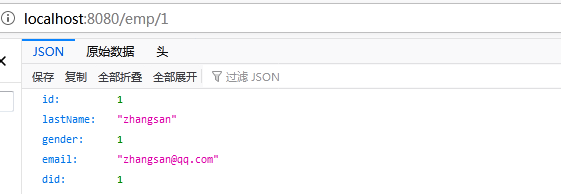文章目录
一、SpringBoot整合基本JDBC
1、查看SpringBoot的默认数据源
1、在配置文件application.yml中配置数据源
spring:
datasource:
username: root
password: 123456
url: jdbc:mysql://192.168.15.22:3306/jdbc
driver-class-name: com.mysql.jdbc.Driver
2、测试类
@RunWith(SpringRunner.class)
@SpringBootTest
class Springboot05DataJdbcApplicationTests {
@Autowired
DataSource dataSource;
@Test
void contextLoads() throws SQLException {
System.out.println(dataSource.getClass());
Connection connection = dataSource.getConnection();
System.out.println(connection);
connection.close();
}
}
效果:
- 默认使用com.zaxxer.hikari.HikariDataSource作为数据源;
- 数据源的相关配置都在DataSourceProperties里面;
2、自动建表
-
spring.datasource下有两个属性 schme、data,其中schema为表初始化语句,data为数据初始化,默认加载schema.sql与data.sql。脚本位置可以通过spring.datasource.schema 与spring.datasource.data 来改变
-
在application.yml中通过spring.datasource.schema指定建表脚本的位置:

在SpringBoot1.x中, 运行建表脚本不需要配置便可之间运行,但是在SpringBoot2.x中,我们需要在配置文件中配置一下:initialization-mode: always
spring:
datasource:
username: root
password: root
url: jdbc:mysql://192.168.157.129:3306/jdbc
driver-class-name: com.mysql.cj.jdbc.Driver
initialization-mode: always
# 配置自动建表脚本的位置
schema:
- classpath:department.sql
- 运行启动类之后会自动创建department这个表
3、使用JdbcTemplate查表
使用JdbcTemplate查询表中的数据:

@Controller
public class HelloController {
@Autowired
JdbcTemplate jdbcTemplate;
@ResponseBody
@GetMapping("/query")
public Map<String,Object> map(){
List<Map<String, Object>> list = jdbcTemplate.queryForList("select * from department");
return list.get(0);
}
}
说明:在运行主类后,会自动创建department这个表,然后在表中填入数据并保存,但是建完表以后就要将配置文件的指定建表sql脚本的配置给删除,否则再次启动主类,仍会建表,那么保存的数据就没了
# schema:
# - classpath:department.sql

二、SpringBoot整合Druid数据源
1. 引入Druid数据源的依赖
<dependency>
<groupId>com.alibaba</groupId>
<artifactId>druid-spring-boot-starter</artifactId>
<version>1.1.10</version>
</dependency>
2. 在配置文件中切换数据源并配置与数据源相关的属性
spring:
datasource:
username: root
password: root
url: jdbc:mysql://192.168.157.129:3306/jdbc
driver-class-name: com.mysql.cj.jdbc.Driver
# 启动初始化
initialization-mode: always
# 切换数据源的类型
type: com.alibaba.druid.pool.DruidDataSource
# 数据源其他配置
initialSize: 5
minIdle: 5
maxActive: 20
maxWait: 60000
timeBetweenEvictionRunsMillis: 60000
minEvictableIdleTimeMillis: 300000
validationQuery: SELECT 1 FROM DUAL
testWhileIdle: true
testOnBorrow: false
testOnReturn: false
poolPreparedStatements: true
# 配置监控统计拦截的filters,去掉后监控界面sql无法统计,'wall'用于防火墙
filters: stat,wall,log4j
maxPoolPreparedStatementPerConnectionSize: 20
useGlobalDataSourceStat: true
connectionProperties: druid.stat.mergeSql=true;druid.stat.slowSqlMillis=500
3. 编写配置类
@Configuration
public class DruidConfig {
//指定加载appliction.yml文件里面的spring.datasource开头的
// DruidDataSource类里面的属性与appliction.yml文件里面的spring.datasource开头的对应映射
@ConfigurationProperties(prefix = "spring.datasource")
@Bean
public DataSource druid(){
return new DruidDataSource();
}
}
4. 以debug方式测试配置的数据源属性是否成功

注意:在运行测试类的时候报错java.lang.NoClassDefFoundError: org/apache/log4j/Priority,需要在pom.xml中导入依赖:
<dependency>
<groupId>log4j</groupId>
<artifactId>log4j</artifactId>
<version>1.2.17</version>
</dependency>
5. 配置Druid的监控
@Configuration
public class DruidConfig {
@ConfigurationProperties(prefix ="spring.datasource")
@Bean
public DataSource druid(){
return new DruidDataSource();
}
//配置Druid的监控
//1、配置一个管理后台的Servlet
@Bean
public ServletRegistrationBean statViewServlet(){
ServletRegistrationBean bean = new ServletRegistrationBean(new StatViewServlet(), "/druid/*");
Map<String,String> initParams = new HashMap<>();
initParams.put("loginUsername","admin");
initParams.put("loginPassword","123456");
initParams.put("allow","");//默认就是允许所有访问
initParams.put("deny","192.168.15.21");
bean.setInitParameters(initParams);
return bean;
}
//2、配置一个web监控的filter
@Bean
public FilterRegistrationBean webStatFilter(){
FilterRegistrationBean bean = new FilterRegistrationBean();
bean.setFilter(new WebStatFilter());
Map<String,String> initParams = new HashMap<>();
initParams.put("exclusions","*.js,*.css,/druid/*");
bean.setInitParameters(initParams);
bean.setUrlPatterns(Arrays.asList("/*"));
return bean;
}
}

三、SpringBoot整合MyBatis
1. 配置Druid数据源
导入依赖:
<dependency>
<groupId>com.alibaba</groupId>
<artifactId>druid-spring-boot-starter</artifactId>
<version>1.1.10</version>
</dependency>
配置数据源相关属性:
spring:
datasource:
# 数据源的基本配置DruidConfig
username: root
password: root
url: jdbc:mysql://192.168.157.129:3306/mybatis
driver-class-name: com.mysql.cj.jdbc.Driver
# 启动初始化
initialization-mode: always
# 切换数据源的类型
type: com.alibaba.druid.pool.DruidDataSource
# 数据源其他配置
initialSize: 5
minIdle: 5
maxActive: 20
maxWait: 60000
timeBetweenEvictionRunsMillis: 60000
minEvictableIdleTimeMillis: 300000
validationQuery: SELECT 1 FROM DUAL
testWhileIdle: true
testOnBorrow: false
testOnReturn: false
poolPreparedStatements: true
# 配置监控统计拦截的filters,去掉后监控界面sql无法统计,'wall'用于防火墙
filters: stat,wall,log4j
maxPoolPreparedStatementPerConnectionSize: 20
useGlobalDataSourceStat: true
connectionProperties: druid.stat.mergeSql=true;druid.stat.slowSqlMillis=500
创建数据库mybatis:

编写数据源配置类
@Configuration
public class DruidConfig {
@ConfigurationProperties(prefix ="spring.datasource")
@Bean
public DataSource druid(){
return new DruidDataSource();
}
//配置Druid的监控
//1、配置一个管理后台的Servlet
@Bean
public ServletRegistrationBean statViewServlet(){
ServletRegistrationBean bean = new ServletRegistrationBean(new StatViewServlet(), "/druid/*");
Map<String,String> initParams = new HashMap<>();
initParams.put("loginUsername","admin");
initParams.put("loginPassword","123456");
initParams.put("allow","");//默认就是允许所有访问
initParams.put("deny","192.168.15.21");
bean.setInitParameters(initParams);
return bean;
}
//2、配置一个web监控的filter
@Bean
public FilterRegistrationBean webStatFilter(){
FilterRegistrationBean bean = new FilterRegistrationBean();
bean.setFilter(new WebStatFilter());
Map<String,String> initParams = new HashMap<>();
initParams.put("exclusions","*.js,*.css,/druid/*");
bean.setInitParameters(initParams);
bean.setUrlPatterns(Arrays.asList("/*"));
return bean;
}
}
2. 配置启动时初始化的建表脚本
# 启动时初始化的建表语句
schema:
# 一定要注意classpath:后面没有空格
- classpath:sql/department.sql
- classpath:sql/employee.sql
# 启动初始化
initialization-mode: always

运行启动类创建数据表,创建完成后就要将上面的配置删掉,以防启动时再次创建。
3. 创建JavaBean封装表的属性
@Data
public class Employee {
private Integer id;
private String lastName;
private Integer gender;
private String email;
private Integer dId;
}
@Data
public class Department {
private Integer id;
private String departmentName;
}
4. MyBatis注解版
@Mapper
public interface DepartmentMapper {
@Select("select * from department where id=#{id}")
public Department getDeptById(Integer id);
@Delete("delete from department where id=#{id}")
public int deleteDeptById(Integer id);
@Insert("insert into department(departmentName) values(#{departmentName})")
public int insertDept(Department department);
@Update("update department set departmentName=#{departmentName} where id=#{id}")
public int updateDept(Department department);
}
Controller层:
@RestController
public class DeptController {
@Autowired
DepartmentMapper departmentMapper;
//只要传递的参数和类名一致就会自动封装
@GetMapping("/dept")
public Department insertDepartment(Department department){
departmentMapper.insertDept(department);
return department;
}
@GetMapping("/dept/{id}")
public Department getDepartment(@PathVariable("id") Integer id){
return departmentMapper.getDeptById(id);
}
}


可以看到在插入数据时,id=null,但查询出来并不为null,可以开启主键自增功能:
@Options(useGeneratedKeys = true,keyProperty = "id")
@Insert("insert into department(departmentName) values(#{departmentName})")
public int insertDept(Department department);

5. 配置文件版
1、在主类上加上一个注解,用于扫描映射文件的接口的包
@MapperScan("com.hh.springboot.mapper")
@SpringBootApplication
public class Springboot05DataMybatis0Application {
public static void main(String[] args) {
SpringApplication.run(Springboot05DataMybatis0Application.class, args);
}
}
2、EmployeeMapper接口:
public interface EmployeeMapper {
public Employee getEmpById(Integer id);
public void insertEmp(Employee employee);
}
3、EmployeeMapper.xml实现类:
<?xml version="1.0" encoding="UTF-8" ?>
<!DOCTYPE mapper
PUBLIC "-//mybatis.org//DTD Mapper 3.0//EN"
"http://mybatis.org/dtd/mybatis-3-mapper.dtd">
<mapper namespace="com.hh.springboot.mapper.EmployeeMapper">
<select id="getEmpById" resultType="com.hh.springboot.bean.Employee">
SELECT * FROM employee WHERE id=#{id}
</select>
<insert id="insertEmp" useGeneratedKeys="true" keyProperty="id">
INSERT INTO employee(lastName,email,gender,d_id) VALUES (#{lastName},#{email},#{gender},#{dId})
</insert>
</mapper>
4、全局配置文件:
<?xml version="1.0" encoding="UTF-8" ?>
<!DOCTYPE configuration
PUBLIC "-//mybatis.org//DTD Config 3.0//EN"
"http://mybatis.org/dtd/mybatis-3-config.dtd">
<configuration>
<settings>
<setting name="mapUnderscoreToCamelCase" value="true"/>
</settings>
</configuration>
5、Controller层:
@RestController
public class DeptController {
@Autowired
EmployeeMapper employeeMapper;
@GetMapping("/emp/{id}")
public Employee getEmp(@PathVariable("id") Integer id){
return employeeMapper.getEmpById(id);
}
}
6、在配置文件中配置位置:
mybatis:
# 指定全局配置文件位置
config-location: classpath:mybatis/mybatis-config.xml
# 指定sql映射文件位置
mapper-locations: classpath:mybatis/mapper/*.xml

四、SpringBoot整合JPA
1、application.properties
###############数据源配置################
#配置数据源
spring.datasource.username=root
spring.datasource.password=root
spring.datasource.driver-class-name=com.mysql.cj.jdbc.Driver
spring.datasource.url=jdbc:mysql://192.168.157.130/jpa?characterEncoding=utf-8&useSSL=false
###############JPA配置######################
#更新或者创建数据库表结构
spring.jpa.hibernate.ddl-auto=update
#控制台显示SQl
spring.jpa.show-sql=true
2、UserRepository
//完成对数据库的操作
public interface UserRepository extends JpaRepository<User,Integer> {
}
3、User
@Entity说明这个class是实体类,并且使用默认的orm规则,即class名即数据库表中表名,class字段名即表中的字段名
如果想改变这种默认的orm规则,就要使用@Table来改变class名与数据库中表名的映射规则,@Column来改变class中字段名与db中表的字段名的映射规则
[@Entity]
必须与@Id注解 结合使用
否则 No identifier specified for entity:
name 属性
(可选)实体名称。 缺省为实体类的非限定名称。
该名称用于引用查询中的实体。
该名称不能是Java持久性查询语言中的保留字面值。
不与@Table结合的话 表名 默认为 SnakeCaseStrategy(命名策略 )为表名
若使用 name属性 且没有与@Table结合 则表名为 name值的SnakeCaseStrategy(命名策略 )
例如:
@Entity
public class UserEntity{...} 表名 user_entity
@Entity(name="UE")
public class UserEntity{...} 表名 ue
@Entity(name="UsEntity")
public class UserEntity{...} 表名 us_entity
@Entity//告诉JPA这是一个实体类(和数据库表映射的类)
@Table//指定和那个数据库表对应,如果省略就是类名小写
@Data
@JsonIgnoreProperties(value = { "hibernateLazyInitializer", "handler" })
public class User implements Serializable {
@Id//表明这是一个主键
@GeneratedValue(strategy = GenerationType.IDENTITY)//这是一个自增主键
private Integer id;
@Column//这是和数据库表对应的一个列
private String lastName;
@Column//省略列名就是属性名
private String email;
}
4、UserController
@RestController
public class UserController {
@Autowired
UserRepository userRepository;
@GetMapping("/user/{id}")
public User getUser(@PathVariable("id")Integer id){
User user = userRepository.getOne(id);
return user;
}
@GetMapping("/user")
public User insertUser(User user){
User save = userRepository.save(user);
return save;
}
}

